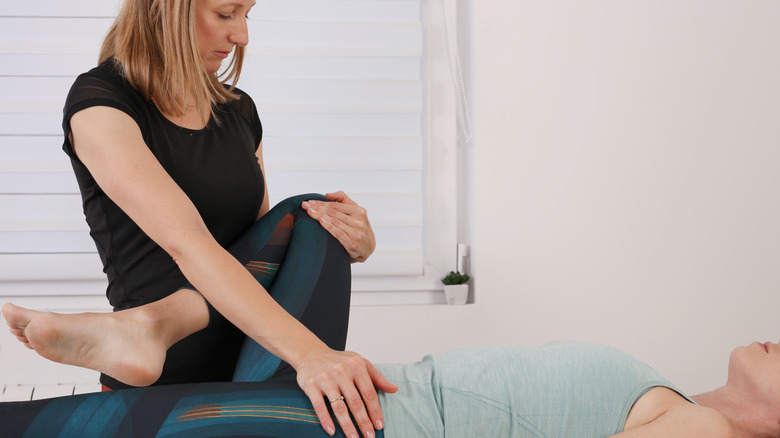Could You Be Clenching Your Pelvic Floor? Here's How To Tell
Despite being one of the most important groups of muscles in the body, there is a general lack of awareness when it comes to the female pelvic floor. The pelvic floor is actually made up of several deep and superficial muscles that stretch from the pubic bone down to the tailbone (via Embrace Physiotherapy). According to a 2008 study published in Gastroenterology Clinics of North America, these muscles work together to support the pelvis, bladder, rectum, and internal reproductive organs. The pelvic floor is also involved in continence control and even helps stabilize the core, which is important for basic body movements, per Cleveland Clinic. Activating your pelvic floor while performing certain movements provides additional support to the core, which helps prevent injury and ensures the proper muscles are activated.
Although the pelvic floor plays a key role in important body mechanics, you don't want your pelvic floor to constantly contract and remain activated. In fact, chronic clenching of the pelvic floor muscles can lead to serious issues, such as pelvic floor dysfunction. Specifically, over-clenching these muscles can result in an overactive or hypertonic pelvic floor, which can cause uncomfortable and even painful symptoms.
How can you tell if you clench your pelvic floor? Here is everything you need to know about over-clenching.
Are you a pelvic clencher?
There are several causes of a tight pelvic floor. Similar to how one clenches their jaw muscles and gets headaches while stressed, the pelvic floor can also be a focal point for stress or anxiety. Other reasons for clenching include weak muscles, poor posture, childbirth, or a sedentary lifestyle, and certain conditions, such as irritable bowel syndrome, post-traumatic stress disorder (PTSD), vulvodynia, or endometriosis (via Cleveland Clinic).
Unlike the muscles in the rest of the body, it can be difficult to tell if you are clenching the muscles of the pelvic floor unless you recognize the signs. If you continuously contract your pelvic floor muscles, whether intentionally or unintentionally, you may experience pain or discomfort in your pelvis, hips, and lower back. Some individuals may also feel tightness or pain around the vaginal opening, while others may feel it closer to the anus. You may even feel a cramping sensation in the pelvis, similar to menstrual cramps.
Long-term clenching, or a hypertonic pelvic floor, can also result in more serious symptoms, such as difficulty urinating, constipation, and pain during sex (via Embrace Physiotherapy). The pelvic floor is involved in bladder control, so if your muscles are already clenched then they're unable to further contract to control the muscles of the bladder, which results in pelvic floor dysfunction. In such cases, performing Kegels is not recommended as it can lead to further discomfort.
How to relax your pelvic floor
At this point, you may have realized that you're a habitual clencher with an overactive pelvic floor. The discomfort, pain, and difficulty during everyday activities that you may experience can be incredibly draining, both physically and emotionally. So, how do you stop clenching your pelvic floor? Thankfully, there are exercises you can perform at home to help you relax your muscles.
If your clenching is due to stress and anxiety, then try practicing mindful breathing to calm your nervous system. Deep belly breathing exercises, or diaphragmatic breathing, can help you manage your stress and relax the pelvic floor when practiced regularly, per Pelvic Health & Rehabilitation Center. Once you've mastered diaphragmatic breathing, try these two pelvis-oriented yoga poses: the cat-cow pose and the happy baby pose. During these slow, gentle stretches, inhale by expanding your belly and imagine the muscles around your vaginal opening and anus relaxing, then slowly exhale. As you exhale, your pelvic floor muscles will naturally contract once more; however, they will be less clenched as you continue to relax and breathe.
While breathing and mindfulness are helpful tools on their own, it is highly recommended that you reach out to a pelvic floor physiotherapist for further help, especially If your symptoms persist or if there is a more serious reason behind your tight pelvic floor, such as PTSD, vulvodynia, or childbirth.


